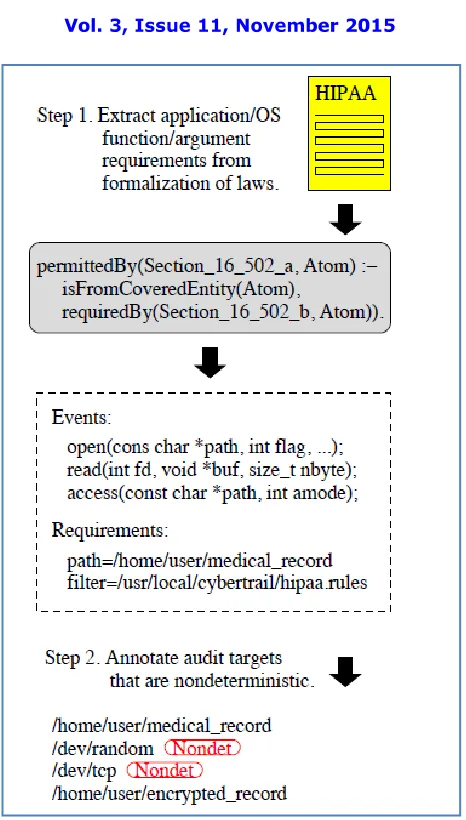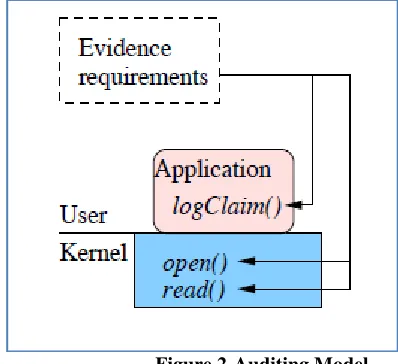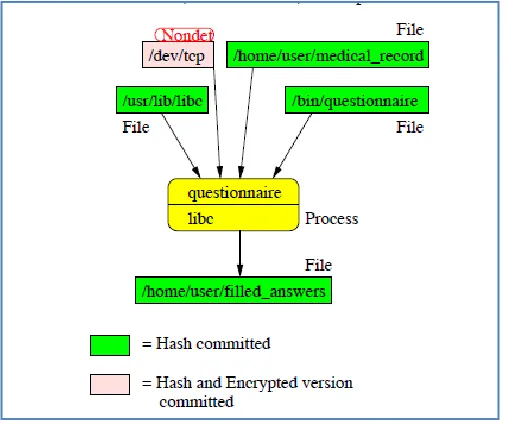Consistency as a Service Auditing Cloud
Consistency
G.V.G Ramesh Naidu, G Lakshmi Vara Prasad
M.Tech Student, Dept. of CSE, QIS College of Engineering and Technology, Ongole, Prakasam (Dt), Andhra Pradesh, India
Assistant Professor, Dept. of IT, QIS College of Engineering and Technology, Ongole, Prakasam (Dt), Andhra Pradesh,
India
ABSTRACT: An increasing number of organizations are migrating their critical information technology services, from
healthcare to business intelligence, into public cloud computing environments. However, even if cloud technologies are continuously evolving, they still have not reached a maturity level that allows them to provide users with high assurance about the security of their data beyond existent service level agreements. To address this limitation, we propose a suite of mechanisms that enhances cloud computing technologies with more assurance capabilities. Assurance becomes a measurable property, quantified by the volume of evidence to audit and retain in a privacy-preserving and non-reputable fashion. By proactively collecting potential forensic evidence, the cloud becomes more accountable, while providing its regular services. In the case of a security breach, the cloud provides the appropriate reactive security framework for validating or repudiating claims. Moreover, different levels of assurance relate to different levels of storage and privacy protection requested by users, leading to an assurance-based price model for cloud services.
I.INTRODUCTION
Digital forensics is playing an increasing important role
In investigating criminal activity. According to the Federal Bureau of Investigations (FBI) [6], in 2011, 4,263 TB of data was processed for digital forensic in 7,629 criminal examinations as opposed to 439 TB and 880 criminal cases in 2003. With the increased migration of critical information technology services into the cloud, digital evidence is poised to become instrumental in investigating criminal activity committed in cloud environments as well. The reasons are manifold – financially lucrative targets are now hosted on clouds, systems are so complex that vulnerabilities are regularly discovered, and digital identities are becoming widespread, making audit trails effective. Verifying security compliance using audit trails is an effective complement to access control systems. The approach supports greater flexibility since security policies can be introduced retrospectively, modified dynamically, and reasonable violations can be accommodated. It is scalable since the auditing granularity can be dynamically tuned.
II.RELATED WORK
Healthcare Systems Many hospitals now outsource their information technology infrastructure to services that are deployed on clouds. A patient wishes to demonstrate that a hospital was negligent in following the proper procedures, while the hospital wishes to demonstrate that there was no lapse on its part. The hospital therefore collects non-reputable evidence for the procedures that it has followed. The patient has a right to examine the evidence that is relevant to his or her treatment. The evidence can be analyzed with respect to the processes that the hospital is required to follow. These processes also pertain to the sharing of medical information as regulated by the Health Insurance Portability and Accountability Act (HIPAA) [12].
Electronic Mail
Email often contains evidence similar to that of physical correspondence, but without the same degree of reliability. To support digital forensics, an electronic mail server must require email to be authenticated by the sender and registered by the receiver. The evidence of the sending and receipt of the electronic mail must be recorded by mail servers residing on clouds. The sequence of mail exchanges can then be used as evidence to establish certain claims. The electronic mail record can also be combined with other forms of evidence to corroborate a breach of contract.
Business Workflow
Many transactions involve work that is sequenced through multiple agents. Each agent can pick up the transaction only when some preconditions have been met. Since these actions are distributed over a network, it is not possible to monitor an entire transaction. Parts of the transaction might also be outsourced across multiple business domains. However, by recording the state of the transaction using cloud services at key points in the workflow, it will be possible to reconstruct the ordering of events to reactively ensure that the business rules have been followed. Evidence-based workflow has applications beyond law enforcement in areas such as software certification and clinical trials.
Online Services
A purchase of services or goods from a service in the cloud can involve a complex sequence of exchanges. For example, an auction involves collecting bids and counterbids to determine a winner. The auditing infrastructure can ensure that the bidding process and winner selection was fair by automatically generating evidence that each participant can use to verify that the process was free of collusion after the auction ends. In particular, it will allow the seller and the bidders to check that previously observable claims are consistent with the end result.
Insider Threats
A security violation occurs when a computing agent obtains unauthorized accesses to a protected resource. By maintaining a record of the accesses along with the permissions and authorizations, a cloud service can detect security violations. This is particularly useful where there are obvious legal and employment consequences to such unauthorized access. While such breaches can also be flagged by an online intrusion detection system, an audit-based approach is open to new forms and sources of evidence and can more easily admit exceptions and policy changes, including those that have retrospective effect.
III.PROPOSED SYSTEM
Figure 1-Proposed Flow of Work
Formal Representation
The first step consists of taking extant laws and extracting from them an abstract description of what elements can serve as digital evidence. For example, a substantial part of HIPAA and portions of other laws have been converted into a formal representation by members of the computer science department and law school at Stanford [3]. Such representations can serve as the basis for defining a set of operating-system- and application-level evidence requirements.
Target Mapping
will suffice for validating an audit record, as demonstrated in the virtual-machine context [5]. The use of a continuous snap shooting file system, such as NILFS [16], will ensure the subsequent availability of data after files are modified or deleted.
Dynamic Auditing
A third step consists of mechanisms to dynamically activate auditing functionality to collect digital evidence when required. Extant systems rely on interfaces that either introduce too much overhead or do not have visibility at the abstraction levels of interest. The use of a trusted kernel can significantly reduce the overhead imposed. For example, the Linux kernel markers insert no-ops that do not adversely affect runtime behavior at locations where auditing functionality is inactive by default and can safely be added subsequently. When a point of interest is determined, the kernel image can be dynamically modified in memory, replacing the specific noops corresponding to a marker with a branch to the requisite auditing code.
Privacy-Aware Evidence Management
The fourth step aims to protect the privacy of users, starting from the point at which audit records are first generated. The approach relies on being able to separate digital evidence that has been deterministically generated from that which is not. For example, the data read from a file is considered to be deterministic if it can be read again from a retained copy (such as one available from a snap shooting file system), whereas data read from a network connection is considered nondeterministic. The vast majority of evidence is deterministic and can be omitted from the evidence record if its sources (which include the program that created it, the runtime environment in which the program started, and all nondeterministic inputs) are retained. The remaining records are a small enough set that they can be encrypted using attribute-based encryption [17] such that only parties with the right set of credentials can access them. Committing signed hashes of an application’ binary and linked libraries, input files, and runtime environment will make it possible to detect if a cloud user claims to have used a different application or inputs from the ones she actually utilized.
Figure 2-Auditing Model
Distributed Trails
distributed journal in the overlay. The functioning of the latter construct will be similar to that of the log used in journaling filesystems [11] with optimization for intra-node locality.
Actuarial Forensics
Finally, rather than attempting to provide an a priori level of auditing, cloud providers allow customers to select a level of service. This assumes a price model based on the quantity of proactively collected forensic evidence and privacy protection, similar to insurance price models. If an application is compromised, the chance of being able to reconstruct the intruder’s actions increases as more detailed evidence is available. The finer granularity of evidence could take the form of higher sampling rate in the case of statistical-based anomaly detection (which requires high fidelity data), or more classes of events and details in the case of specification-based anomaly detection. Both cases impose an overhead in storage and processing resources that the cloud service has to support.
IV.IMPLEMENTATION
Implementation is the stage of the project when the theoretical design is turned out into a working system. Thus it can be considered to be the most critical stage in achieving a successful new system and in giving the user, confidence that the new system will work and be effective.
The implementation stage involves careful planning, investigation of the existing system and it’s constraints on implementation, designing of methods to achieve changeover and evaluation of changeover methods.
Modules
1. User Module.
2. Auditor module.
3. Admin Module.
4. Data upload madule(in cloud database)
Modules Description
UserModule
In this module, user should register their details and get the secret key for loggin …… and user can upload the
file regarding the auditing ……..
Auditor Module
In this module, auditor can do the auditing based on the heuristic auditing strategy. Its relates with document verification….
Auditor can check the auditing file he can neglate or accept the file he can revise the report and check whether its good or bad….
And auditor can give revision report like accept or waiting …
If status in accept means user can view the file else status is waiting means user cant view the file…..
Admin module:
In this module admin can view all the user details , user uploads details, And TPA activties….regarding the auditing strategy.
Data upload module (in cloud database)
V.SIMULATION RESULTS
The above steps towards an accountable cloud will offer the following security guarantees: Evidence completeness: The formal representation and target mapping steps will ensure that all the relevant evidence (according to the extant laws) is collected. User privacy-preservation: The privacy-aware evidence management step will ensure that the users’ privacy is protected, by applying attribute-based encryption to the audited data generated by users’ activity. Audit-trail non-repudiation: The distributed trails steps will ensure that that the audit trails are non-reputable non-reputable by storing them in distributed journals. The guarantee increases with scale.
The need for accountable cloud has been identified also by Haeberlen, who emphasized the benefits for both the customers and the cloud providers [10]. His work was “intended as a call for action”, which we followed, by providing more steps towards accountable cloud. Our approach calls for proactive collection of forensic evidence which is then examined to identify criminal activity. Possible approaches for forensic analysis include online intrusion detection using a rule-based expert system to examine audit data to identify possible unauthorized access in a system. The rules are based on the typical patterns and profiles of attacker behavior. Auditing has been used to monitor threats against Air Force computers by Anderson as far back as 1980 [1]. Most host-based intrusion detection systems use logs [2]. A number of research efforts have focused on log management. Schneier analyzed the problem of maintaining the integrity of log files on a host [22]. Silbert considered the problem of secure auditing in a distributed system [23]. Flack focused on reconstructing formal semantics from logs [7]. Roger implemented an online algorithm that checks the model defined by declarative constraints stated in a temporal logic against log records [20]. Marty proposes the use of use-case oriented logging for forensic analysis of cloud applications [15]. The main concern we focus on is whether sufficient auditing can be performed within a budget to be able to prove in a court of law that the evidence supports a specific claim that a violation did or did not occur.
Figure 3-Encryption Model
as done by sandboxing schemes [8], or a kernel module that intercedes at the system call interface directly, such as the auditing library lib-audit and its associated tools that are included in prominent Linux distributions.
These approaches have substantially improved performance though they are unable to audit application-level function calls. The SystemTap project [18] allows a wider range of instrumentation, with visibility into the kernel itself, and allows specifications to be written at an abstract level that is then automatically compiled into C, which in turn produces a kernel module. However, all these approaches rely on trace hooks or trace points in the kernel where a check is done to see if the event is of interest, in which case an audit record is generated. The side effect of the branch that must be performed is that a cache miss results, slowing down performance even when no auditing is active. Our proposed approach using Linux kernel markers does not suffer from this.
VI.CONCLUSION AND FUTURE WORK
Due to the continuous migration of organizations’ critical information technology into the cloud, we believe that the cloud providers should make a concerted effort towards accountable clouds. Assurance of the security of their customers’ data can be formalized by first-class SLA clauses. These can be supported in practice by a number of steps we introduce here, aiming to make cloud computing more accountable by proactively collecting forensic evidence. These steps include mapping laws into evidentiary requirements, targeting these into system-specific evidence descriptions, dynamically activating auditing as needed, cryptographically protecting the resulting evidence, distributing the audit trails so they cannot be repudiated and providing varying levels of auditing according to the level of forensic assurance needed by the customers.
REFERENCES
[1] James P. Anderson, Computer security threat monitoring and surveillance, Technical Report, Fort Washington, PA, 1980.
[2] Stefan Axelsson, Intrusion detection systems: A survey and taxonomy, Technical Report 99-15, Chalmers University of Technology Department of Computer Engineering, March 2000.
[3] Adam Barth, Design and analysis of privacy policies, Ph.D. Thesis, Stanford University, 2008.
[4] R. Dingledine, N. Mathewson, and P. Syverson, Tor: The secondgeneration onion router, 13th Conference on USENIX Security Symposium, 2004. [5] George W. Dunlap, Samuel T. King, Sukru Cinar, Murtaza Basrai, and Peter M. Chen, ReVirt: Enabling intrusion analysis through virtualmachine logging and replay, Symposium on Operating Systems Design and Implementation, 2002.
[6] Regional Computer Forensics Laboratory Program, Annual Report for Fiscal Year 2011, http://www.rcfl.gov/downloads/documents/RCFL Nat Annual11.pdf
[7] Chapman Flack and Mikhail J. Atallah, Better logging through formality: Applying formal specification techniques to improve audit logs and log consumers, Recent Advances in Intrusion Detection, 2000.
[8] Ian Goldberg, David Wagner, Randi Thomas, and Eric A. Brewer, A secure environment for untrusted helper applications, 6th Usenix Security Symposium, 1996.
[9] Andreas Haeberlen, Petr Kouznetsov, and Peter Druschel, PeerReview: Practical accountability for distributed systems, 21st ACM Symposium on Operating Systems Principles, 2007.
[10] Andreas Haeberlen, A Case for the Accountable Cloud, 3rd ACM SIGOPS International Workshop on Large-Scale Distributed Systems and Middleware, 2009.
[11] R. Hagmann, Reimplementing the Cedar file system using logging and group commit, 11th ACM Symposium on Operating Systems Principles, 1987. [12] http://www.cms.hhs.gov/SecurityStandard/
[13] Kapil Jain and R. Sekar, User-level infrastructure for system call interposition: A platform for intrusion detection and confinement, ISOC Network and Distributed Systems Symposium, 2000.
[14] Renico Koen, The development of an open-source forensics platform, M.Sc. Thesis, University of Pretoria, 2009. [15] Raffael Marty, Cloud application logging for forensics, ACM Symposium on Applied Computing, 2011. [16] NILFS, http://www.nilfs.org/en/
[17] Rafail Ostrovsky, Amit Sahai, and Brent Waters, Attribute-based encryption with non-monotonic access structures, 14th ACM Conference on Computer and Communications Security, 2007.
[18] V. Prasad, W. Cohen, F. C. Eigler, M. Hunt, J. Keniston, and B. Chen, Locating system problems using dynamic instrumentation, Ottawa Linux Symposium, 2005.
[20] Muriel Roger and Jean Goubault-Larrecq, Log auditing through model checking, 14th IEEE Computer Security Foundations Workshop, 2001. [21] Keyun Ruan, Joe Carthy, Tahar Kechadi and Mark Crosbie, Cloud forensics: an overview, Advances in Digital Forensics, Vol. 7, 2011.
[22] Bruce Schneier and John Kelsey, Secure audit logs to support computer forensics, ACM Transactions on Information and System Security, 2(2), pp. 159-176, May 1999.
[23] W. Olin Sibert, Auditing in a distributed system: Secure SunOS audit trails, 11th National Computer Security Conference, 1988.
BIOGRAPHY
Mr.G.V.G Ramesh Naidu Pursuing His M. Tech (CSE) from QIS College of Engineering and Technology, Prakasam(Dt),
Andhra Pradesh. His areas of interest are Cloud Computing, Security and Data Mining.
Mr. G.Lakshmi Vara Prasad , working as an Assistant Professor, Department of IT, QIS College of Engineering and


